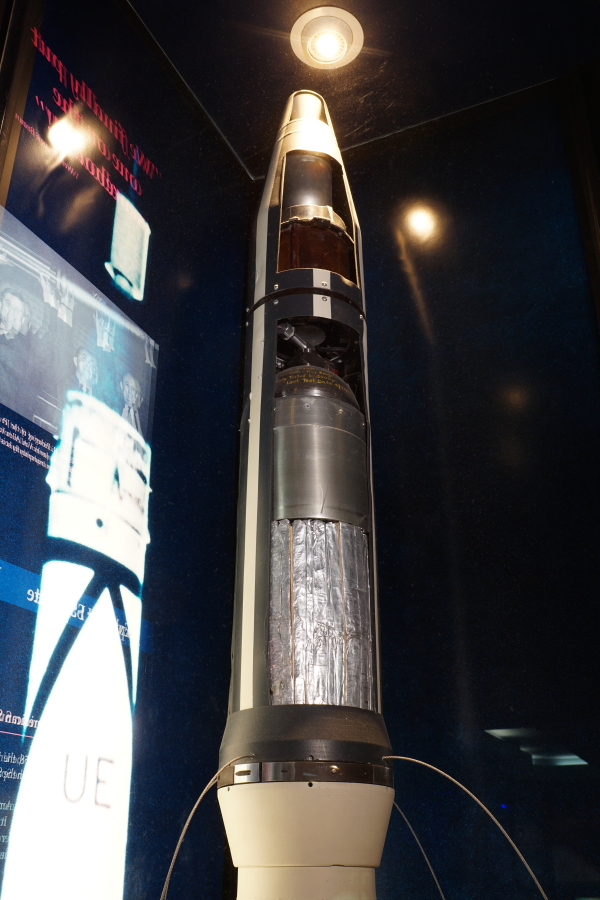| Prev |
heroicrelics.org Kansas Cosmosphere Site Index First Satellites Gallery |
Next |
dscc5456.jpg
Detail of the forward portion of the Explorer/Beacon backup unit.
Picture 1 of 2.
Strictly speaking, earlier Explorer satellites remained attached to their scaled Sergeant solid rocket motor fourth stages, so this is actually a photo of the satellite proper.
The accompanying sign notes that this was to have been launched as part of the Beacon program. The Beacon satellites differed from their Explorer predecessors in that the diameter of the satellite was increased from 6 inches (which matched the diameter of the Sergeant motor) to 7 inches in order to accommodate the increased Beacon payload, an aluminum-foil covered inflatable plastic sphere for measuring high altitude atmospheric density by observation of its orbital characteristics. The balloon was developed at Langley Research Center (which also did the preliminary design of the more famous Project Echo satellite, which also featured an inflatable sphere, this time 100 feet in diameter).
Another difference in the Beacon satellites from the earlier Explorers is that the former included a two-pound, solid-propellant "kick motor" at the forward end of the satellite to raise and circularize its orbit, raising its perigee from 75 to nearly 500 miles (120 to nearly 800 kilometers). The fifth stage kick motor is visible through the cutaway of the aerodynamic fairing at the forward end of the satellite.
The adapter between the fourth stage and the satellite proper also differed from previous Explorer satellites and apparently contributed to its failure to orbit. The Beacon adapter consisted of back-to-back truncated cones (frustums), whereas previous payloads were simply bolted to the fourth stage. The Beacon satellite was designed to separate from the fourth stage, both to allow ejection of the balloon package and to minimize the mass the fifth stage had to accelerate.
Finally, note the "whisker" antenna at the aft end of the satellite.
The only actual Beacon launch attempt, atop Juno I Round 49 (the Juno I flights were referred to as "rounds", presumably a hold-over from the early Army philosophy that missiles were an extension of artillery) on October 22, 1958 failed to place the satellite in orbit due to an inadvertent separation of the payload from the fourth stage 111.5 seconds after liftoff.

| Time picture taken | Thu Apr 14 14:58:20 2016 |
| Location picture taken |
Cold War Gallery Space Hall Kansas Cosmosphere Hutchinson, KS |
| Prev |
heroicrelics.org Kansas Cosmosphere Site Index First Satellites Gallery |
Next |